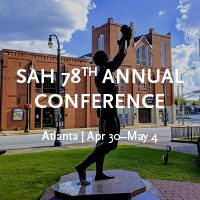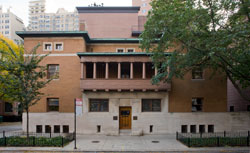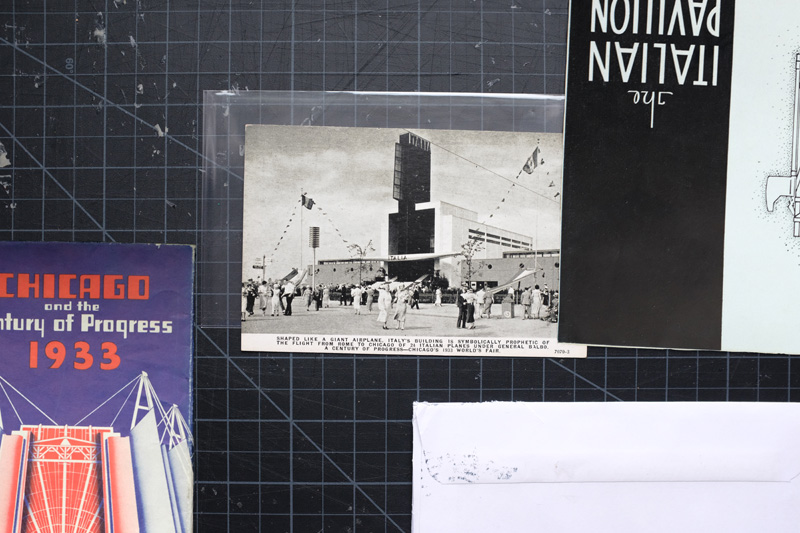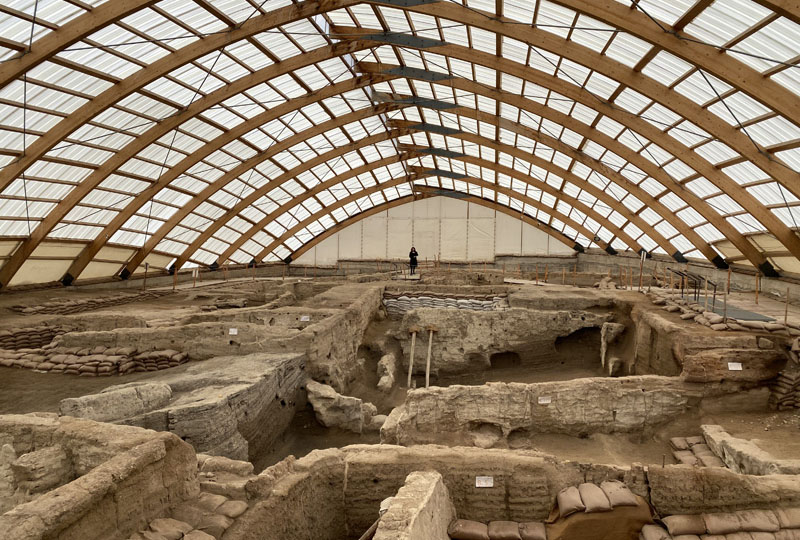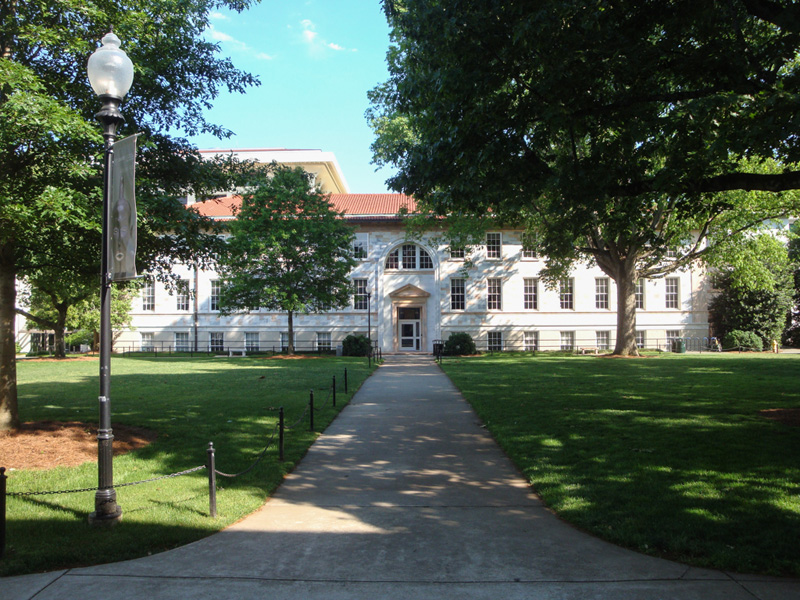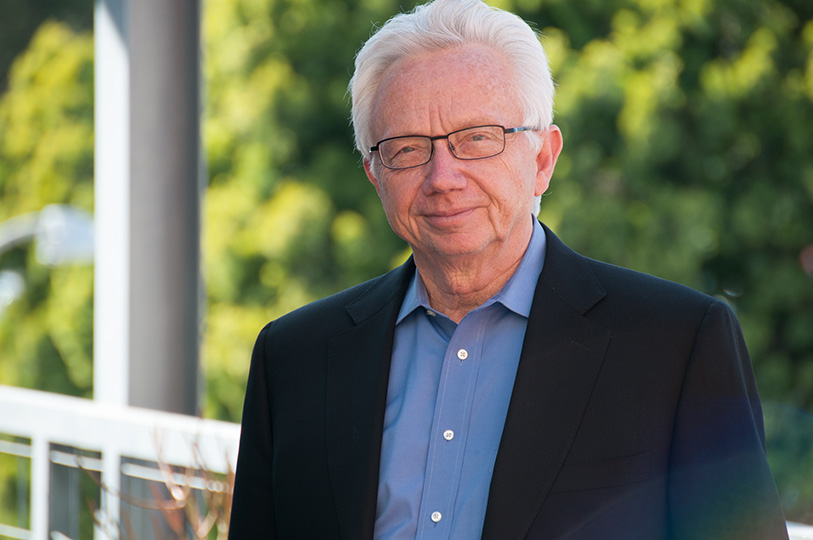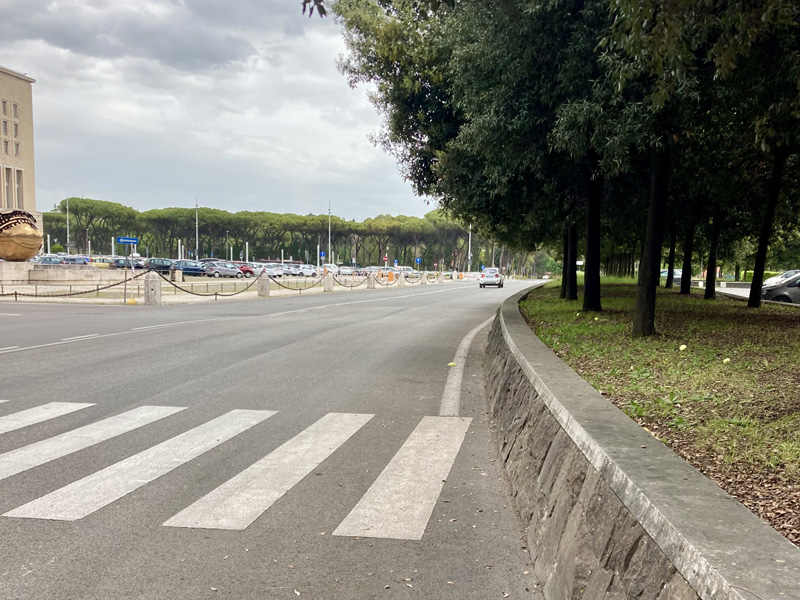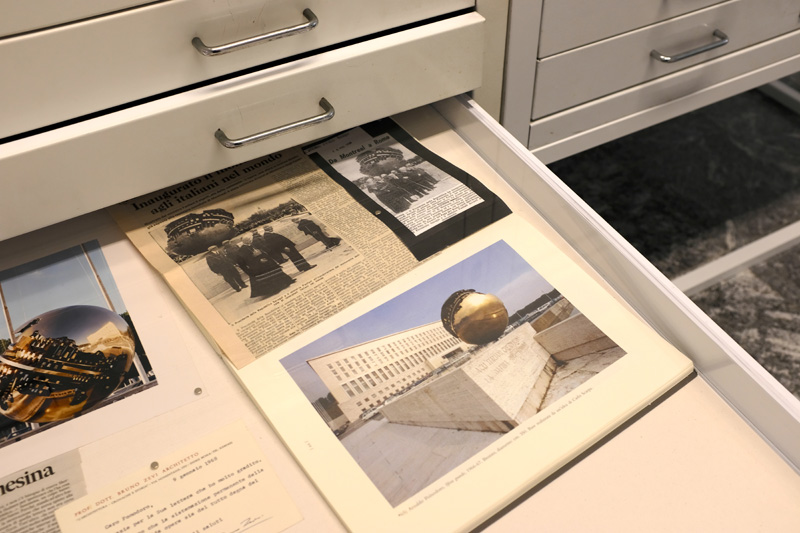-
Membership
Membership
Anyone with an interest in the history of the built environment is welcome to join the Society of Architectural Historians -
Conferences
Conferences
SAH Annual International Conferences bring members together for scholarly exchange and networking -
Publications
Publications
Through print and digital publications, SAH documents the history of the built environment and disseminates scholarshipLatest Issue:
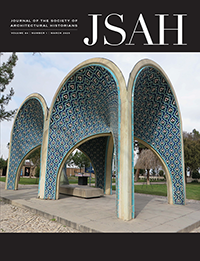
-
Programs
Programs
SAH promotes meaningful engagement with the history of the built environment through its programsMember Programs
-
Jobs & Opportunities
Jobs & Opportunities
SAH provides resources, fellowships, and grants to help further your career and professional life -
Support
Support
We invite you to support the educational mission of SAH by making a gift, becoming a member, or volunteering -
About
About
SAH promotes the study, interpretation, and conservation of the built environment worldwide for the benefit of all
Learning from History to Protect Human Health
Apr 22, 2025
by
SAH News
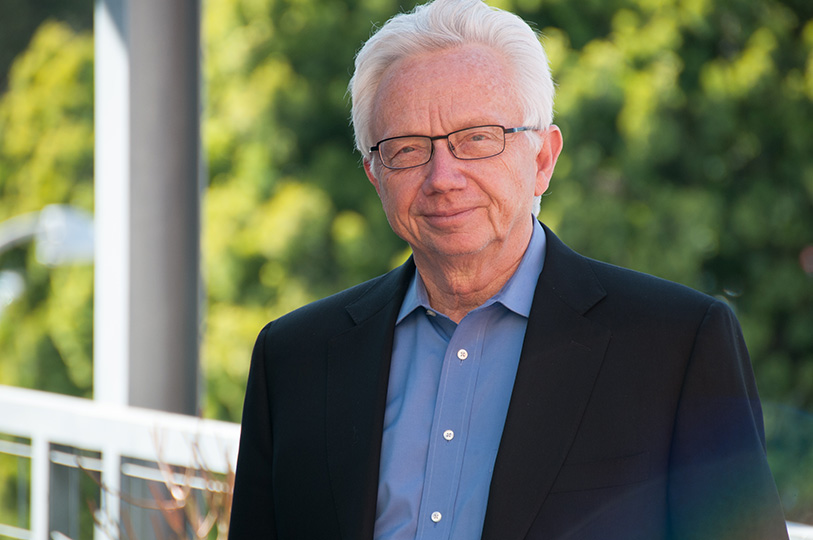
Richard Joseph Jackson, MD MPH FAAP HonAIA HonFASLA, is Professor emeritus at the Fielding School of Public Health at UCLA, where he was Department Chair in Environmental Health Sciences. A pediatrician, he served in many leadership positions with the California Health Department, including the highest as the State Health Officer. For nine years he was Director of the CDC’s National Center for Environmental Health and received the Presidential Distinguished Service Award at the White House. In October 2011 he was elected to the National Academy of Medicine (NAM) and has co-led NAM’s Health and Climate and the Gun Violence Interest Groups.
Dick Jackson lectures and speaks on multiple issues, particularly those related to Climate Heating, Architecture, Children, and Health. He co-authored the books: Urban Sprawl and Public Health, Making Healthy Places, and Designing Healthy Communities for which he hosted a four-hour PBS series.
On May 1, 2025, he will deliver the 7th annual Eduard F. Sekler Talk to the Society of Architectural Historians at its 78th International Conference in Atlanta.
We sat down with Jackson ahead of his address to learn more about his interests in architecture and where he sees possible collaboration between historians and health professionals.
_________________________________________________
When and how did you first become interested in the intersection of public health and architecture?
Several aspects of my early life and career got me thinking about the connection between space, exposure, and health. It wasn’t something I was consciously aware of at the time, but became apparent to me later in life.
My first passion was for infectious diseases. My father died of polio in just two days when I was three years old. That clearly had an impact on my interests. And in medical school at the University of California, San Francisco, we learned virtually nothing about public health and epidemiology. We were scarcely taught preventive medicine. I became hungry for that knowledge.
I wanted to get into things that were vital to the well-being of everybody, but especially children and those who are most vulnerable. Working with children’s health, you inevitably end up working on injury prevention, dangerous conditions, and exposures, which is tightly linked to the built environment.
Much later at the CDC, I dealt with a breadth of issues, from lead poisoning, asthma, and profiling of chemical exposures for the American people, which clearly have links to our built environment as well.
My conviction that our public health is rooted in our man-made environments comes from many different pieces of evidence from across the span of medicine.
In general, how does our everyday physical environment affect our health?
We Americans spend 99% of our time existing in the built environments in one form or another —homes, offices, cars, highways, sidewalks, parks, etc. And they're so present in our lives. We're unaware of just how much of our daily actions they are controlling. Where we work, how much we walk or exercise, how much we socialize are dictated by our built environment.
I can tell you there are ways to build a hospital that makes it feel clinical and isolating or to enhance your comfort and sense of well-being which helps you get well faster.
There’s a popular narrative in the early 20th century that cities are bad for health: Too many people with too much waste in cramped conditions. Can you talk about that?
Before a more recent issue, the American Public Health Association's last publication on built environment and health was back during the 1920’s. And what you described truly was the thinking: Living in squalor and too much density in very poor quality environments was always associated with bad urban places. Suburbs were touted as a healthful reprieve.
And it was successful, getting people into less density and better conditions. The affordability of automobiles, spreading out, moderate density and better control of both wastewater, drinking water, and immunization. All those things are success stories.
Boy, this is so American, though, isn't it? We find a success story, and we overdo it until we ruin it. Once, the car was seen as liberating. Ask anybody living in Los Angeles or any of our major cities today if being in a car liberating. They'll tell you, ‘No, it's like being in jail.’
So, you can build to make life better for people and easier and more enjoyable, and to build social capital, or you can build to isolate people and destroy social and cultural capital. But, to think that we will continue to be successful if we stop paying attention to our environments is a disaster.
In your line of work, what is the value in studying past forms of architecture and urban design?
Architecture reflects the knowledge and values of each civilization. From their architecture, you can quickly figure out what's most important to a group of people.
We as human beings have known how to build really good places for generations. You go back to the Fertile Crescent between the Tigris and Euphrates Rivers, and they were creating buildings that were naturally air-conditioned. In ancient Persian, the word Paradise meant ‘garden.’ They understood that attachment to a garden was essential to mental, social, and physical well-being.
Our modern word quarantine is drawn from the number of days — quaranta days, 40 days—the ages-past shipping empire of Venice would require ships to anchor at specially-designed islands to ensure that diseases were quelled or ran their course before being brought into the port. In fact, the U.S. Public Health Service insignia includes an anchor, making reference to this practice of maintaining places of quarantine to protect the population from sickness and epidemics.
For the nine years you were the Director of the CDC’s National Center for Environmental Health you lived and worked in Atlanta, the site of this year’s SAH Conference and Sekler Talk. What lessons did this city teach you about public landscape planning and health?
My family relocated when I took the role with the CDC. My wife and I did what all parents do when moving with children; We researched good public schools and tried to live nearby. We settled in North Atlanta, and our children took buses to attend three different schools at their varying ages. Some of those schools didn’t have sidewalks within two miles of them. The only way to get there was in a car or on the bus. Students have been killed trying to cross busy streets trying to get home after after-school activities. That’s a public health issue.
I was shocked that everywhere I went there were no sidewalks, and you didn't see people out walking. It’s hot in Atlanta, why would you want to walk? Well, it’s especially hot when there are no trees along paved streets that lead to major businesses and services. One day in my car I passed an old woman trudging alongside the road carrying two bags of groceries. And I thought to myself, ‘Gosh, if she collapses in the ditch, the emergency team that finds her may list her cause of death as heat stroke, but in reality she will have died of inadequate public walkways. We just aren’t in the habit of thinking of it that way.
What research questions do you have that architectural historians are well-situated to answer?
At the Centers for Disease Control, we reserved three percent of every grant we awarded for evaluation. We felt it was important to look back and evaluate how a grantee’s work was going, as well as what they're doing and what works and what doesn't work. It was our way of building in course-correction, if you will, over time.
Failure analysis is essential. And it isn’t done to blame somebody; It is done to find the lessons we can apply. I’ll speak about the construction of hospitals. We will make mistakes, even with the best planning. In one case I remember, the hospital architects didn’t include bedpan washing facilities. Hugely important for sanitation, right? But it was missed.
Historians can be failure analysis people, in a way, can’t they? Or success analysis. I think many people – myself included at a young age – feel history is all names, dates, and places strung out in a line never ending. But it’s really about pattern recognition, much like medicine is. As we look at the history, what does what we know about buildings, cities, gardens suggest about the kinds of policies we need now? That’s immensely valuable to me.
Can you give us a teaser of one of the stories or case studies you will share in your Eduard F. Sekler talk on May 1?
In 1999, I vowed I would never give another talk without reflecting on climate heating and climate change. Expect to hear about how built environment contributes to heat and heat to human health.
Unrelated, I wrote an epilogue for the book Epidemic Urbanism: Contagious Diseases in Global Cities co-edited by Mohammad Gharipour – who invited me to speak to SAH – and Caitlin DeClercq. In that epilogue, I wrote, “Learning about the past is important, but learning from the past is urgent.” It's important to look back, but it's also very important to see how it informs us as we look forward, and that will be my theme.
Row White
Lorem ipsum dolor sit amet, consectetur adipiscing elit, sed do eiusmod tempor incididunt ut labore et dolore magna aliqua. Ut enim ad minim veniam, quis nostrud exercitation ullamco laboris nisi ut aliquip ex ea commodo consequat. Duis aute irure dolor in reprehenderit in voluptate velit esse cillum dolore eu fugiat nulla pariatur. Excepteur sint occaecat cupidatat non proident, sunt in culpa qui officia deserunt mollit anim id est laborum.
Row BG Green
Lorem ipsum dolor sit amet, consectetur adipiscing elit, sed do eiusmod tempor incididunt ut labore et dolore magna aliqua. Ut enim ad minim veniam, quis nostrud exercitation ullamco laboris nisi ut aliquip ex ea commodo consequat. Duis aute irure dolor in reprehenderit in voluptate velit esse cillum dolore eu fugiat nulla pariatur. Excepteur sint occaecat cupidatat non proident, sunt in culpa qui officia deserunt mollit anim id est laborum.
Row Gray
Lorem ipsum dolor sit amet, consectetur adipiscing elit, sed do eiusmod tempor incididunt ut labore et dolore magna aliqua. Ut enim ad minim veniam, quis nostrud exercitation ullamco laboris nisi ut aliquip ex ea commodo consequat. Duis aute irure dolor in reprehenderit in voluptate velit esse cillum dolore eu fugiat nulla pariatur. Excepteur sint occaecat cupidatat non proident, sunt in culpa qui officia deserunt mollit anim id est laborum.
Row Green
Lorem ipsum dolor sit amet, consectetur adipiscing elit, sed do eiusmod tempor incididunt ut labore et dolore magna aliqua. Ut enim ad minim veniam, quis nostrud exercitation ullamco laboris nisi ut aliquip ex ea commodo consequat. Duis aute irure dolor in reprehenderit in voluptate velit esse cillum dolore eu fugiat nulla pariatur. Excepteur sint occaecat cupidatat non proident, sunt in culpa qui officia deserunt mollit anim id est laborum.
Row CP Dark
Lorem ipsum dolor sit amet, consectetur adipiscing elit, sed do eiusmod tempor incididunt ut labore et dolore magna aliqua. Ut enim ad minim veniam, quis nostrud exercitation ullamco laboris nisi ut aliquip ex ea commodo consequat. Duis aute irure dolor in reprehenderit in voluptate velit esse cillum dolore eu fugiat nulla pariatur. Excepteur sint occaecat cupidatat non proident, sunt in culpa qui officia deserunt mollit anim id est laborum.
Heading 1
Lorem ipsum dolor sit amet, consectetur adipiscing elit, sed do eiusmod tempor incididunt ut labore et dolore magna aliqua. Ut enim ad minim veniam, quis nostrud exercitation ullamco laboris nisi ut aliquip ex ea commodo consequat. Duis aute irure dolor in reprehenderit in voluptate velit esse cillum dolore eu fugiat nulla pariatur. Excepteur sint occaecat cupidatat non proident, sunt in culpa qui officia deserunt mollit anim id est laborum.
Heading 2
Lorem ipsum dolor sit amet, consectetur adipiscing elit, sed do eiusmod tempor incididunt ut labore et dolore magna aliqua. Ut enim ad minim veniam, quis nostrud exercitation ullamco laboris nisi ut aliquip ex ea commodo consequat. Duis aute irure dolor in reprehenderit in voluptate velit esse cillum dolore eu fugiat nulla pariatur. Excepteur sint occaecat cupidatat non proident, sunt in culpa qui officia deserunt mollit anim id est laborum.
Heading 3
Lorem ipsum dolor sit amet, consectetur adipiscing elit, sed do eiusmod tempor incididunt ut labore et dolore magna aliqua. Ut enim ad minim veniam, quis nostrud exercitation ullamco laboris nisi ut aliquip ex ea commodo consequat. Duis aute irure dolor in reprehenderit in voluptate velit esse cillum dolore eu fugiat nulla pariatur. Excepteur sint occaecat cupidatat non proident, sunt in culpa qui officia deserunt mollit anim id est laborum.
Heading 4
Lorem ipsum dolor sit amet, consectetur adipiscing elit, sed do eiusmod tempor incididunt ut labore et dolore magna aliqua. Ut enim ad minim veniam, quis nostrud exercitation ullamco laboris nisi ut aliquip ex ea commodo consequat. Duis aute irure dolor in reprehenderit in voluptate velit esse cillum dolore eu fugiat nulla pariatur. Excepteur sint occaecat cupidatat non proident, sunt in culpa qui officia deserunt mollit anim id est laborum.
Heading 5
Lorem ipsum dolor sit amet, consectetur adipiscing elit, sed do eiusmod tempor incididunt ut labore et dolore magna aliqua. Ut enim ad minim veniam, quis nostrud exercitation ullamco laboris nisi ut aliquip ex ea commodo consequat. Duis aute irure dolor in reprehenderit in voluptate velit esse cillum dolore eu fugiat nulla pariatur. Excepteur sint occaecat cupidatat non proident, sunt in culpa qui officia deserunt mollit anim id est laborum.
Heading 6
Lorem ipsum dolor sit amet, consectetur adipiscing elit, sed do eiusmod tempor incididunt ut labore et dolore magna aliqua. Ut enim ad minim veniam, quis nostrud exercitation ullamco laboris nisi ut aliquip ex ea commodo consequat. Duis aute irure dolor in reprehenderit in voluptate velit esse cillum dolore eu fugiat nulla pariatur. Excepteur sint occaecat cupidatat non proident, sunt in culpa qui officia deserunt mollit anim id est laborum.
lead
Blockquote: Lorem ipsum dolor sit amet, consectetur adipiscing elit, sed do eiusmod tempor incididunt ut labore et dolore magna aliqua. Ut enim ad minim veniam, quis nostrud exercitation ullamco laboris nisi ut aliquip ex ea commodo consequat. Duis aute irure dolor in reprehenderit in voluptate velit esse cillum dolore eu fugiat nulla pariatur. Excepteur sint occaecat cupidatat non proident, sunt in culpa qui officia deserunt mollit anim id est laborum.
- List Item
- List Item
- List Item
- List Item
- List Item
- List Item
Two Buttons in one paragraph
Expandable List
At the center of SAH Celebrates is the Charnley-Persky House (1891–1892), a National Historic Landmark and a Chicago Landmark designed by Louis Sullivan with assistance from Frank Lloyd Wright, that serves as SAH headquarters. SAH Celebrates highlights the importance of fostering a supportive community whose efforts ensure the stewardship of architectural gems like the Charnley-Persky House.
Proceeds benefit the ongoing maintenance and care of the Charnley-Persky House and SAH's educational programs and publications, including SAH Archipedia and Buildings of the United States.
T. Gunny Harboe, FAIA
Founder, Harboe Architects
Michelangelo Sabatino, PhD
Professor, Director of Ph.D. Program in Architecture, Inaugural John Vinci Distinguished Research Fellow, Illinois Institute of Technology
Founder, Harboe Architects
Michelangelo Sabatino, PhD
Professor, Director of Ph.D. Program in Architecture, Inaugural John Vinci Distinguished Research Fellow, Illinois Institute of Technology
Laurence O. Booth, FAIA
Booth Hansen Architects
Rebekah Coffman
Chicago History Museum
Stuart Cohen, FAIA
Cohen-Hacker Architects
Thomas M. Dietz
Alison Fisher
Art Institute of Chicago
Scott Fortman
Institute of Classical Architecture and Art, Chicago-Midwest Chapter
Keith Goad
The Keith Goad Group, Berkshire Hathaway Home Services Chicago
Chandra Goldsmith
IIT CoA Board of Advisors
Barbara Gordon
Frank Lloyd Wright Building Conservancy
Eleanor Gorski
Chicago Architecture Center
Stuart Graff
Frank Lloyd Wright Foundation
Julie Hacker, FAIA
Cohen-Hacker Architects
Sarah Herda
Graham Foundation
Harry Hunderman, FAIA
Wiss, Janney, Elstner Associates, Inc
Lisa Key
Driehaus Museum
Nancy and Thomas Klein
SAH Chicago Chapter
Thomas Leslie
University of Illinois at Urbana-Champaign
Jen Masengarb
AIA Chicago
Bonnie McDonald
Landmarks Illinois
Justin Miller
Docomomo US/Chicago
Ward Miller
Preservation Chicago
Heather Hyde Minor
University of Notre Dame
Keith N. Morgan, FSAH
SAH Past President
Sarah Rogers Morris
University of Illinois at Chicago
John K. Notz Jr.
SAH Benefactor Member
Keith Olsen
Olsen Vranas Architects
Abby Persky
Chicago, IL
Laurie Petersen
Charnley-Persky House Board Member
Charlie Pipal
School of the Art Institute of Chicago
Deborah Slaton
Wiss, Janney, Elstner Assocites, Inc.
Cynthia Vranas
Mies Van der Rohe Society
Cynthia Weese, FAIA
Weese, Langley, Weese Architects and Charnley-Persky House Board Member
Ernie Wong
Commission on Chicago Landmarks
Booth Hansen Architects
Rebekah Coffman
Chicago History Museum
Stuart Cohen, FAIA
Cohen-Hacker Architects
Thomas M. Dietz
Jaeger Nickola Kuhlman & Associates
Art Institute of Chicago
Scott Fortman
Institute of Classical Architecture and Art, Chicago-Midwest Chapter
Keith Goad
The Keith Goad Group, Berkshire Hathaway Home Services Chicago
Chandra Goldsmith
IIT CoA Board of Advisors
Barbara Gordon
Frank Lloyd Wright Building Conservancy
Eleanor Gorski
Chicago Architecture Center
Stuart Graff
Frank Lloyd Wright Foundation
Julie Hacker, FAIA
Cohen-Hacker Architects
Sarah Herda
Graham Foundation
Harry Hunderman, FAIA
Wiss, Janney, Elstner Associates, Inc
Lisa Key
Driehaus Museum
Nancy and Thomas Klein
SAH Chicago Chapter
Thomas Leslie
University of Illinois at Urbana-Champaign
Jen Masengarb
AIA Chicago
Bonnie McDonald
Landmarks Illinois
Justin Miller
Docomomo US/Chicago
Ward Miller
Preservation Chicago
Heather Hyde Minor
University of Notre Dame
Keith N. Morgan, FSAH
SAH Past President
Sarah Rogers Morris
University of Illinois at Chicago
John K. Notz Jr.
SAH Benefactor Member
Keith Olsen
Olsen Vranas Architects
Abby Persky
Chicago, IL
Laurie Petersen
Charnley-Persky House Board Member
Charlie Pipal
School of the Art Institute of Chicago
Deborah Slaton
Wiss, Janney, Elstner Assocites, Inc.
Chris-Annmarie Spencer, AIA, NOMA
AIA Chicago Foundation
Cynthia Vranas
Mies Van der Rohe Society
Cynthia Weese, FAIA
Weese, Langley, Weese Architects and Charnley-Persky House Board Member
Ernie Wong
Commission on Chicago Landmarks
Download the prospectus for information about sponsorship and advertising opportunities. Please contact Ben Thomas at 312-573-1365 if you have questions.
Category Dropdown
OOTB Cards
Card
Card.Alt

Card Title
Card Text - Lorem ipsum dolor sit amet, consectetur adipiscing elit, sed do eiusmod tempor incididunt ut labore et dolore magna aliqua.

Card Title
Card Text - Lorem ipsum dolor sit amet, consectetur adipiscing elit, sed do eiusmod tempor incididunt ut labore et dolore magna aliqua.

Card Title
Card Text - Lorem ipsum dolor sit amet, consectetur adipiscing elit, sed do eiusmod tempor incididunt ut labore et dolore magna aliqua.
Card.Simple

Card Title
Card Text - Lorem ipsum dolor sit amet, consectetur adipiscing elit, sed do eiusmod tempor incididunt ut labore et dolore magna aliqua.
Card.Hero
Card Title
Card Text - Lorem ipsum dolor sit amet, consectetur adipiscing elit, sed do eiusmod tempor incididunt ut labore et dolore magna aliqua.

Card Title
Card Text - Lorem ipsum dolor sit amet, consectetur adipiscing elit, sed do eiusmod tempor incididunt ut labore et dolore magna aliqua.
Card Title
Card Text - Lorem ipsum dolor sit amet, consectetur adipiscing elit, sed do eiusmod tempor incididunt ut labore et dolore magna aliqua.

Card Title
Card Text - Lorem ipsum dolor sit amet, consectetur adipiscing elit, sed do eiusmod tempor incididunt ut labore et dolore magna aliqua.
Card ButtonCustom Cards
List.Custom Card
List.Custom Card 2 Column
List.Custom Card 3 Column
List.Custom Card 4 Column
Detail.Card
Detail.Card Alt
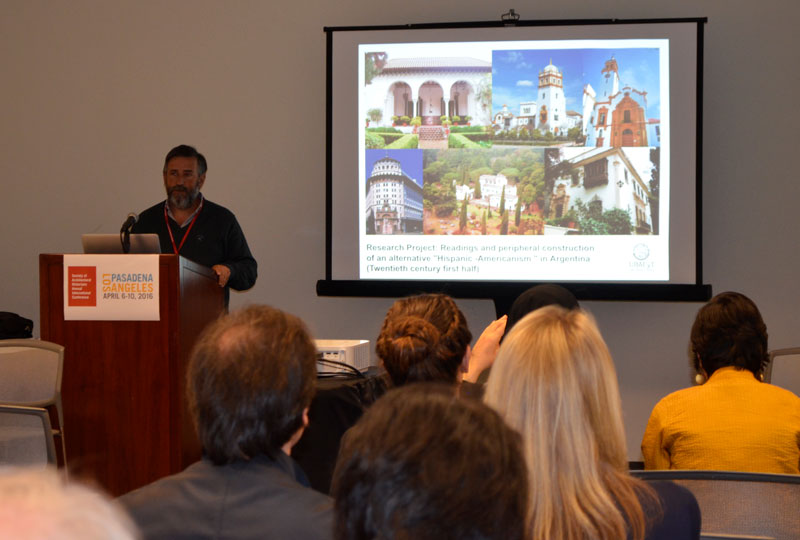
Annual Conference Fellowships
Conference fellowships support session chairs and speakers participating in the SAH Annual International Conference.
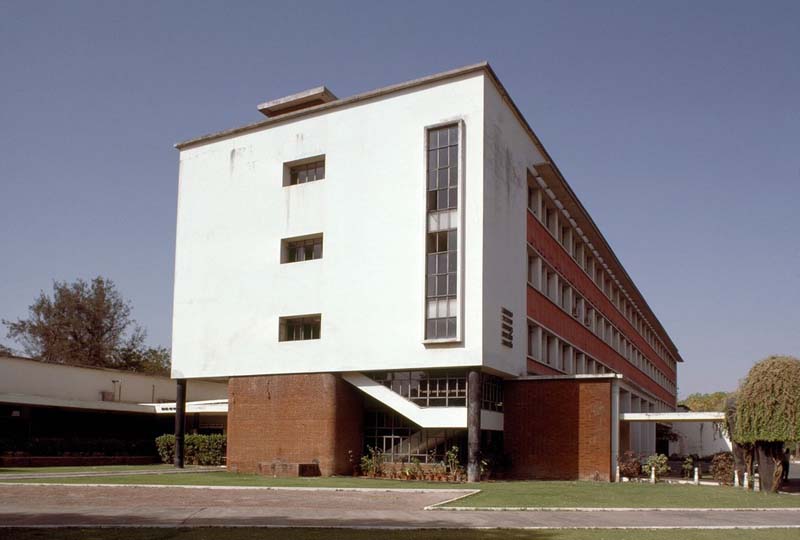

Detail.Card Simple

Another Card Title With Extra Text
This is a card summary. Has a limit of 255 characters. We can increase that if you think we need more text.
Detail.Card Hero


Content Types
Blogs
Blog List
Events
Events List
Events Home Blocks
News
News List
Learning from History to Protect Human Health
Apr 22, 2025
by
SAH News

Richard Joseph Jackson, MD MPH FAAP HonAIA HonFASLA, is Professor emeritus at the Fielding School of Public Health at UCLA, where he was Department Chair in Environmental Health Sciences. A pediatrician, he served in many leadership positions with the California Health Department, including the highest as the State Health Officer. For nine years he was Director of the CDC’s National Center for Environmental Health and received the Presidential Distinguished Service Award at the White House. In October 2011 he was elected to the National Academy of Medicine (NAM) and has co-led NAM’s Health and Climate and the Gun Violence Interest Groups.
Dick Jackson lectures and speaks on multiple issues, particularly those related to Climate Heating, Architecture, Children, and Health. He co-authored the books: Urban Sprawl and Public Health, Making Healthy Places, and Designing Healthy Communities for which he hosted a four-hour PBS series.
On May 1, 2025, he will deliver the 7th annual Eduard F. Sekler Talk to the Society of Architectural Historians at its 78th International Conference in Atlanta.
We sat down with Jackson ahead of his address to learn more about his interests in architecture and where he sees possible collaboration between historians and health professionals.
_________________________________________________
When and how did you first become interested in the intersection of public health and architecture?
Several aspects of my early life and career got me thinking about the connection between space, exposure, and health. It wasn’t something I was consciously aware of at the time, but became apparent to me later in life.
My first passion was for infectious diseases. My father died of polio in just two days when I was three years old. That clearly had an impact on my interests. And in medical school at the University of California, San Francisco, we learned virtually nothing about public health and epidemiology. We were scarcely taught preventive medicine. I became hungry for that knowledge.
I wanted to get into things that were vital to the well-being of everybody, but especially children and those who are most vulnerable. Working with children’s health, you inevitably end up working on injury prevention, dangerous conditions, and exposures, which is tightly linked to the built environment.
Much later at the CDC, I dealt with a breadth of issues, from lead poisoning, asthma, and profiling of chemical exposures for the American people, which clearly have links to our built environment as well.
My conviction that our public health is rooted in our man-made environments comes from many different pieces of evidence from across the span of medicine.
In general, how does our everyday physical environment affect our health?
We Americans spend 99% of our time existing in the built environments in one form or another —homes, offices, cars, highways, sidewalks, parks, etc. And they're so present in our lives. We're unaware of just how much of our daily actions they are controlling. Where we work, how much we walk or exercise, how much we socialize are dictated by our built environment.
I can tell you there are ways to build a hospital that makes it feel clinical and isolating or to enhance your comfort and sense of well-being which helps you get well faster.
There’s a popular narrative in the early 20th century that cities are bad for health: Too many people with too much waste in cramped conditions. Can you talk about that?
Before a more recent issue, the American Public Health Association's last publication on built environment and health was back during the 1920’s. And what you described truly was the thinking: Living in squalor and too much density in very poor quality environments was always associated with bad urban places. Suburbs were touted as a healthful reprieve.
And it was successful, getting people into less density and better conditions. The affordability of automobiles, spreading out, moderate density and better control of both wastewater, drinking water, and immunization. All those things are success stories.
Boy, this is so American, though, isn't it? We find a success story, and we overdo it until we ruin it. Once, the car was seen as liberating. Ask anybody living in Los Angeles or any of our major cities today if being in a car liberating. They'll tell you, ‘No, it's like being in jail.’
So, you can build to make life better for people and easier and more enjoyable, and to build social capital, or you can build to isolate people and destroy social and cultural capital. But, to think that we will continue to be successful if we stop paying attention to our environments is a disaster.
In your line of work, what is the value in studying past forms of architecture and urban design?
Architecture reflects the knowledge and values of each civilization. From their architecture, you can quickly figure out what's most important to a group of people.
We as human beings have known how to build really good places for generations. You go back to the Fertile Crescent between the Tigris and Euphrates Rivers, and they were creating buildings that were naturally air-conditioned. In ancient Persian, the word Paradise meant ‘garden.’ They understood that attachment to a garden was essential to mental, social, and physical well-being.
Our modern word quarantine is drawn from the number of days — quaranta days, 40 days—the ages-past shipping empire of Venice would require ships to anchor at specially-designed islands to ensure that diseases were quelled or ran their course before being brought into the port. In fact, the U.S. Public Health Service insignia includes an anchor, making reference to this practice of maintaining places of quarantine to protect the population from sickness and epidemics.
For the nine years you were the Director of the CDC’s National Center for Environmental Health you lived and worked in Atlanta, the site of this year’s SAH Conference and Sekler Talk. What lessons did this city teach you about public landscape planning and health?
My family relocated when I took the role with the CDC. My wife and I did what all parents do when moving with children; We researched good public schools and tried to live nearby. We settled in North Atlanta, and our children took buses to attend three different schools at their varying ages. Some of those schools didn’t have sidewalks within two miles of them. The only way to get there was in a car or on the bus. Students have been killed trying to cross busy streets trying to get home after after-school activities. That’s a public health issue.
I was shocked that everywhere I went there were no sidewalks, and you didn't see people out walking. It’s hot in Atlanta, why would you want to walk? Well, it’s especially hot when there are no trees along paved streets that lead to major businesses and services. One day in my car I passed an old woman trudging alongside the road carrying two bags of groceries. And I thought to myself, ‘Gosh, if she collapses in the ditch, the emergency team that finds her may list her cause of death as heat stroke, but in reality she will have died of inadequate public walkways. We just aren’t in the habit of thinking of it that way.
What research questions do you have that architectural historians are well-situated to answer?
At the Centers for Disease Control, we reserved three percent of every grant we awarded for evaluation. We felt it was important to look back and evaluate how a grantee’s work was going, as well as what they're doing and what works and what doesn't work. It was our way of building in course-correction, if you will, over time.
Failure analysis is essential. And it isn’t done to blame somebody; It is done to find the lessons we can apply. I’ll speak about the construction of hospitals. We will make mistakes, even with the best planning. In one case I remember, the hospital architects didn’t include bedpan washing facilities. Hugely important for sanitation, right? But it was missed.
Historians can be failure analysis people, in a way, can’t they? Or success analysis. I think many people – myself included at a young age – feel history is all names, dates, and places strung out in a line never ending. But it’s really about pattern recognition, much like medicine is. As we look at the history, what does what we know about buildings, cities, gardens suggest about the kinds of policies we need now? That’s immensely valuable to me.
Can you give us a teaser of one of the stories or case studies you will share in your Eduard F. Sekler talk on May 1?
In 1999, I vowed I would never give another talk without reflecting on climate heating and climate change. Expect to hear about how built environment contributes to heat and heat to human health.
Unrelated, I wrote an epilogue for the book Epidemic Urbanism: Contagious Diseases in Global Cities co-edited by Mohammad Gharipour – who invited me to speak to SAH – and Caitlin DeClercq. In that epilogue, I wrote, “Learning about the past is important, but learning from the past is urgent.” It's important to look back, but it's also very important to see how it informs us as we look forward, and that will be my theme.
News Home Blocks
Learning from History to Protect Human Health
Apr 22, 2025
by
SAH News

Richard Joseph Jackson, MD MPH FAAP HonAIA HonFASLA, is Professor emeritus at the Fielding School of Public Health at UCLA, where he was Department Chair in Environmental Health Sciences. A pediatrician, he served in many leadership positions with the California Health Department, including the highest as the State Health Officer. For nine years he was Director of the CDC’s National Center for Environmental Health and received the Presidential Distinguished Service Award at the White House. In October 2011 he was elected to the National Academy of Medicine (NAM) and has co-led NAM’s Health and Climate and the Gun Violence Interest Groups.
Dick Jackson lectures and speaks on multiple issues, particularly those related to Climate Heating, Architecture, Children, and Health. He co-authored the books: Urban Sprawl and Public Health, Making Healthy Places, and Designing Healthy Communities for which he hosted a four-hour PBS series.
On May 1, 2025, he will deliver the 7th annual Eduard F. Sekler Talk to the Society of Architectural Historians at its 78th International Conference in Atlanta.
We sat down with Jackson ahead of his address to learn more about his interests in architecture and where he sees possible collaboration between historians and health professionals.
_________________________________________________
When and how did you first become interested in the intersection of public health and architecture?
Several aspects of my early life and career got me thinking about the connection between space, exposure, and health. It wasn’t something I was consciously aware of at the time, but became apparent to me later in life.
My first passion was for infectious diseases. My father died of polio in just two days when I was three years old. That clearly had an impact on my interests. And in medical school at the University of California, San Francisco, we learned virtually nothing about public health and epidemiology. We were scarcely taught preventive medicine. I became hungry for that knowledge.
I wanted to get into things that were vital to the well-being of everybody, but especially children and those who are most vulnerable. Working with children’s health, you inevitably end up working on injury prevention, dangerous conditions, and exposures, which is tightly linked to the built environment.
Much later at the CDC, I dealt with a breadth of issues, from lead poisoning, asthma, and profiling of chemical exposures for the American people, which clearly have links to our built environment as well.
My conviction that our public health is rooted in our man-made environments comes from many different pieces of evidence from across the span of medicine.
In general, how does our everyday physical environment affect our health?
We Americans spend 99% of our time existing in the built environments in one form or another —homes, offices, cars, highways, sidewalks, parks, etc. And they're so present in our lives. We're unaware of just how much of our daily actions they are controlling. Where we work, how much we walk or exercise, how much we socialize are dictated by our built environment.
I can tell you there are ways to build a hospital that makes it feel clinical and isolating or to enhance your comfort and sense of well-being which helps you get well faster.
There’s a popular narrative in the early 20th century that cities are bad for health: Too many people with too much waste in cramped conditions. Can you talk about that?
Before a more recent issue, the American Public Health Association's last publication on built environment and health was back during the 1920’s. And what you described truly was the thinking: Living in squalor and too much density in very poor quality environments was always associated with bad urban places. Suburbs were touted as a healthful reprieve.
And it was successful, getting people into less density and better conditions. The affordability of automobiles, spreading out, moderate density and better control of both wastewater, drinking water, and immunization. All those things are success stories.
Boy, this is so American, though, isn't it? We find a success story, and we overdo it until we ruin it. Once, the car was seen as liberating. Ask anybody living in Los Angeles or any of our major cities today if being in a car liberating. They'll tell you, ‘No, it's like being in jail.’
So, you can build to make life better for people and easier and more enjoyable, and to build social capital, or you can build to isolate people and destroy social and cultural capital. But, to think that we will continue to be successful if we stop paying attention to our environments is a disaster.
In your line of work, what is the value in studying past forms of architecture and urban design?
Architecture reflects the knowledge and values of each civilization. From their architecture, you can quickly figure out what's most important to a group of people.
We as human beings have known how to build really good places for generations. You go back to the Fertile Crescent between the Tigris and Euphrates Rivers, and they were creating buildings that were naturally air-conditioned. In ancient Persian, the word Paradise meant ‘garden.’ They understood that attachment to a garden was essential to mental, social, and physical well-being.
Our modern word quarantine is drawn from the number of days — quaranta days, 40 days—the ages-past shipping empire of Venice would require ships to anchor at specially-designed islands to ensure that diseases were quelled or ran their course before being brought into the port. In fact, the U.S. Public Health Service insignia includes an anchor, making reference to this practice of maintaining places of quarantine to protect the population from sickness and epidemics.
For the nine years you were the Director of the CDC’s National Center for Environmental Health you lived and worked in Atlanta, the site of this year’s SAH Conference and Sekler Talk. What lessons did this city teach you about public landscape planning and health?
My family relocated when I took the role with the CDC. My wife and I did what all parents do when moving with children; We researched good public schools and tried to live nearby. We settled in North Atlanta, and our children took buses to attend three different schools at their varying ages. Some of those schools didn’t have sidewalks within two miles of them. The only way to get there was in a car or on the bus. Students have been killed trying to cross busy streets trying to get home after after-school activities. That’s a public health issue.
I was shocked that everywhere I went there were no sidewalks, and you didn't see people out walking. It’s hot in Atlanta, why would you want to walk? Well, it’s especially hot when there are no trees along paved streets that lead to major businesses and services. One day in my car I passed an old woman trudging alongside the road carrying two bags of groceries. And I thought to myself, ‘Gosh, if she collapses in the ditch, the emergency team that finds her may list her cause of death as heat stroke, but in reality she will have died of inadequate public walkways. We just aren’t in the habit of thinking of it that way.
What research questions do you have that architectural historians are well-situated to answer?
At the Centers for Disease Control, we reserved three percent of every grant we awarded for evaluation. We felt it was important to look back and evaluate how a grantee’s work was going, as well as what they're doing and what works and what doesn't work. It was our way of building in course-correction, if you will, over time.
Failure analysis is essential. And it isn’t done to blame somebody; It is done to find the lessons we can apply. I’ll speak about the construction of hospitals. We will make mistakes, even with the best planning. In one case I remember, the hospital architects didn’t include bedpan washing facilities. Hugely important for sanitation, right? But it was missed.
Historians can be failure analysis people, in a way, can’t they? Or success analysis. I think many people – myself included at a young age – feel history is all names, dates, and places strung out in a line never ending. But it’s really about pattern recognition, much like medicine is. As we look at the history, what does what we know about buildings, cities, gardens suggest about the kinds of policies we need now? That’s immensely valuable to me.
Can you give us a teaser of one of the stories or case studies you will share in your Eduard F. Sekler talk on May 1?
In 1999, I vowed I would never give another talk without reflecting on climate heating and climate change. Expect to hear about how built environment contributes to heat and heat to human health.
Unrelated, I wrote an epilogue for the book Epidemic Urbanism: Contagious Diseases in Global Cities co-edited by Mohammad Gharipour – who invited me to speak to SAH – and Caitlin DeClercq. In that epilogue, I wrote, “Learning about the past is important, but learning from the past is urgent.” It's important to look back, but it's also very important to see how it informs us as we look forward, and that will be my theme.
